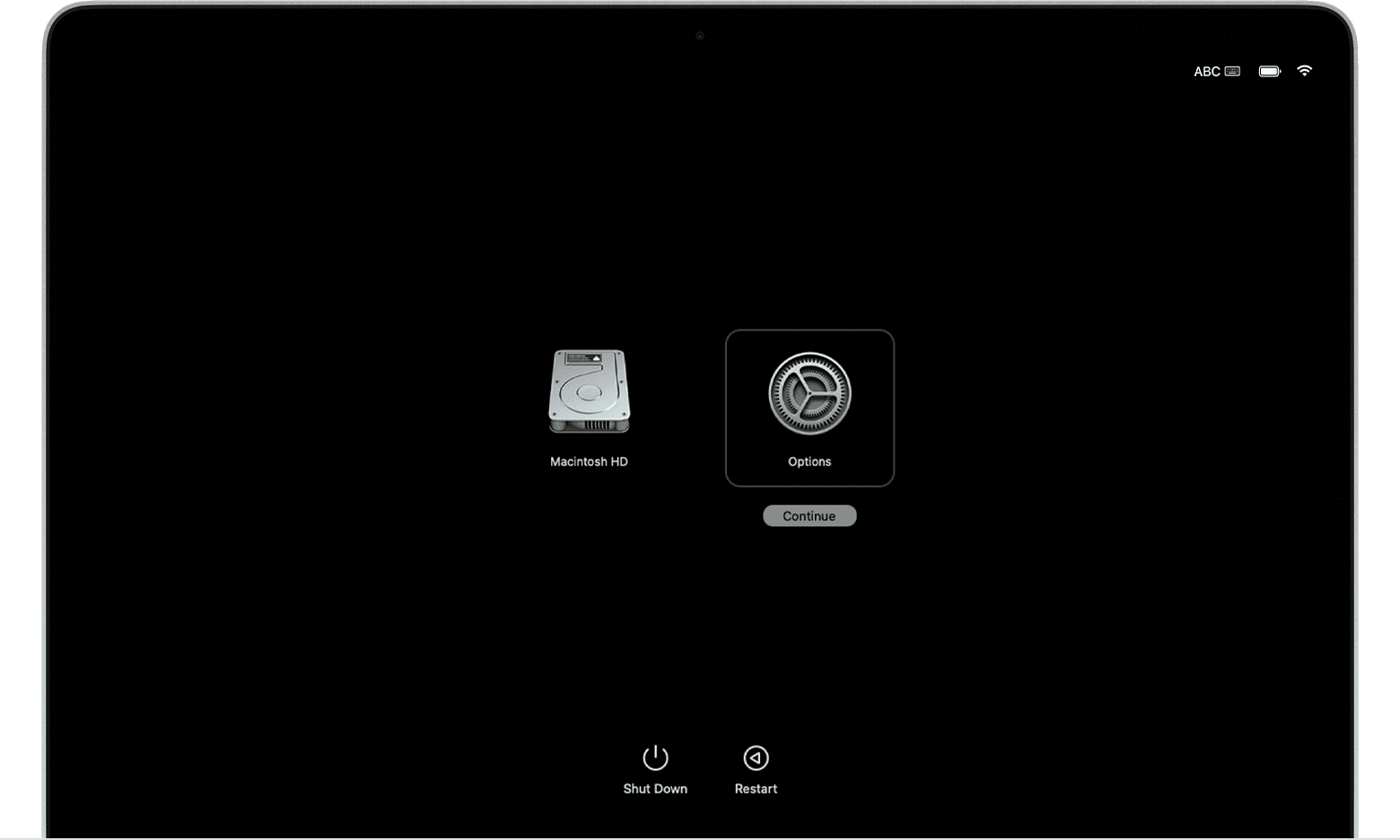If you can't reset your Mac login password
If the standard steps to reset the password of your Mac user account haven't been successful, try these additional steps.
Before you begin
First try the standard steps to reset your Mac login password.
If those steps don't succeed, press and hold the power button on your Mac for up to 10 seconds, until your Mac turns off. Then follow the steps below.
Start up from macOS Recovery
Follow the appropriate steps, based on whether you're using a Mac with Apple silicon. If you’re not sure, you can try both sets of steps.
If using a Mac with Apple silicon
Press and hold the power button on your Mac.
As you continue to hold the power button, your Mac will turn on and load the startup options. When you see Options, release the power button.
Click Options, then click the Continue button below it.

If using any other Mac
Press and release the power button to turn on your Mac.
Immediately after releasing the power button, press and hold Command (⌘)-R.
Keep holding the keys until you see an Apple logo or spinning globe.
You might be asked to select a network from the , or attach a network cable. If you can’t see a Wi-Fi menu, look for it in the top right-hand corner of the screen.
If asked to select an admin user
As you're starting up from macOS Recovery, you might be asked to select an admin user you know the password for. If so, click “Forgot all passwords?” and proceed as described below, based on what your Mac asks for next – your Apple ID or your recovery key.
If you're not asked to select an admin user, skip to Use the Reset Password assistant.
If asked for your Apple ID information
After clicking “Forgot all passwords?”, if you're asked for your Apple ID information:
Enter your Apple ID information.
If asked, enter the verification code sent to your other devices.
If asked select a user that you want to reset the password for:
Select the user, then enter your new password information and click Next.
After authentication has been successful, click Exit.
Choose Apple menu > Restart, then log in with your new password. Password reset is now complete. You don’t need to take additional steps.
If you see an Activation Lock window, click Exit to Recovery Utilities, then skip to Use the Reset Password assistant.
If asked for your recovery key
After clicking “Forgot all passwords?”, if you're asked for your FileVault recovery key:
Enter your FileVault recovery key. You'll have received it when you turned on FileVault and chose to create a recovery key instead of allowing your iCloud account (Apple ID) to unlock your disk.
When prompted to reset your password, click Reset Password.
Select a user to reset the password for.
After authentication has been successful, click Exit.
Choose Apple menu > Restart, then log in with your new password. Password reset is now complete. You don’t need to take additional steps.
Use the Reset Password assistant
After starting up from macOS Recovery, if you didn't reset your password using your Apple ID information or recovery key, you should see the utilities window. It shows options such as restoring from Time Machine, reinstalling macOS, and using Disk Utility.

From the Utilities menu in the menu bar, choose Terminal.
In the Terminal window, type
resetpassword, then press Return to open the Reset Password assistant.If asked to select an admin user you know the password for, click “Forgotten all passwords?”.
At the Reset Password window, click Deactivate Mac, then click Deactivate to confirm.
If you see an Activation Lock window, enter your Apple ID email address and password, then click Next.
At the Reset Password window, enter your new password information, then click Next. (If this window lists multiple user accounts, click the Set Password button next to each account name, then enter the new password information for each account.)
When the password reset process has been completed, click Exit.
Choose Apple menu > Restart, then log in with your new password.
If you still can't reset your password
If no other solution is successful, you can reset your password by erasing your Mac.
Shut down your Mac, then start up from macOS recovery as described previously.
When asked to select an admin user you know the password for, choose Recovery Assistant > Erase Mac from the menu bar.
From the Erase Mac window, click Erase Mac, then click Erase Mac to confirm.
If your Mac restarts to a flashing question mark, press and hold the power button for a few seconds until your Mac turns off.
Start up from macOS Recovery again, then reinstall macOS. Find out how to reinstall macOS.
If you need help
If you need help, please contact Apple Support.
If you erased your Mac and now can't reinstall macOS because the installer doesn't see a hard disk on which to install, you might need to change the format of the disk:
Press Command (⌘)-Q to quit the installer.
When you see the utilities window, select Disk Utility, then click Continue.
Select the first item listed in the sidebar of the Disk Utility window. This is your built-in hard disk.
Click the Erase button or tab on the right side of the window, then enter these details:
Name: Macintosh HD
Format: Mac OS Extended (Journaled)
Scheme (if shown): GUID Partition Map
Click Erase, then click Erase to confirm.
When the erase process has been completed, press Command-Q to quit Disk Utility and return to the utilities window. You should now be able to reinstall macOS successfully.
